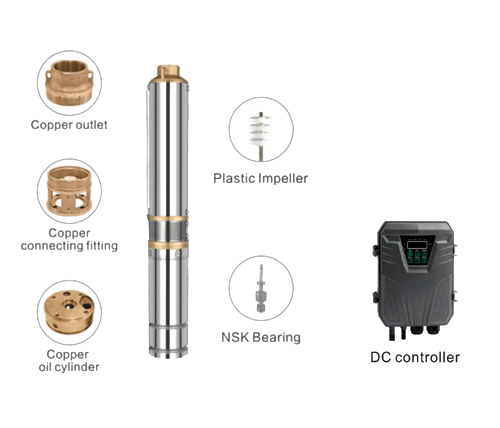Industry News
View All Products
en
Water Filled Solar Pumps are innovative devices that harness solar energy to pump water. They are widely used in various applications, such as irrigation, domestic water supply, and livestock watering. Proper installation and regular maintenance are crucial to ensure the efficient and long-term operation of these pumps.
Installation of Water Filled Solar Pump
1. Site Selection
The step in installing a Water Filled Solar Pump is to choose an appropriate site for the solar panels. The location should be open and unobstructed, with at least six hours of direct sunlight per day. The panels should face true south (or true north in the Southern Hemisphere) and be tilted at an angle that maximizes solar exposure. The pump itself should be installed at a suitable height above the water source, ensuring that it is not too deep to avoid unnecessary strain on the pumping system.

2. Component Selection
Select all system components, including solar panels, the Water Filled Solar Pump, cables, and other necessary accessories, based on the calculated load and power requirements. Ensure that the components are compatible with each other to achieve performance.
3. Mounting the Solar Panels
Prepare the groundwork for installing the mounting structure for the solar panels. Securely mount the panels on the structure and connect them in series or parallel, depending on the system voltage and power needs. Use MC4 connectors for module interconnections and ensure all cables are neatly secured.
4. Installing the Pump
For surface pumps, install the Water Filled Solar Pump near the water source. For submersible pumps, lower them into the bore well or water source pipeline. Ensure that the pump is at least 1 meter above the bottom of the borehole to prevent it from operating dry. Connect the pump to the solar panels via the controller, ensuring all electrical connections are secure and properly insulated.
5. Connecting Pipelines
Connect the suction and delivery pipelines between the water source and the destination water storage tanks. Ensure that the pipes are tightly sealed to prevent water leakage. For submersible pumps, a non-return valve should be installed in the discharge pipe just above the pump.
6. Testing the System
Once the installation is complete, power on the system and test the Water Filled Solar Pump to ensure it is functioning correctly. Check for any unusual noises or vibrations and ensure that water is being pumped efficiently. Adjust any components as necessary to optimize performance.
Maintenance of Water Filled Solar Pump
1. Regular Cleaning
To maintain the efficiency of the Water Filled Solar Pump, regularly clean the solar panels to remove dust and debris that can block sunlight and reduce energy conversion efficiency. Clean the filter and foam mesh filter membrane of the pump to prevent clogging, which can reduce water flow and strain the pump. Use a soft brush and clean water to clean these components.
2. Inspecting Components
Inspect the impeller and flow valve of the Water Filled Solar Pump monthly for any blockages or foreign matter. Check the bearings for smooth operation and replace them if necessary. Examine the pipeline quarterly for any signs of damage or aging and replace problematic parts promptly.
3. Electrical Checks
Ensure all electrical connections are secure and free from corrosion. Check the pump controller for any signs of wear and tear, and keep it clean to prevent dust accumulation. Install surge protectors to shield the system from voltage spikes caused by lightning or other electrical disturbances.
4. Comprehensive Maintenance
Conduct a comprehensive inspection and maintenance of the Water Filled Solar Pump system at least once a year. This includes checking all components, cleaning the system thoroughly, and testing its performance. Record the operation data to identify any potential issues early on.
Precautions for Winter or Freezing Conditions
1. Draining the System
In winter, when the Water Filled Solar Pump is not in use, it is essential to drain the water stored in the pump and pipelines to prevent freezing damage. Freezing water can expand and cause pipes to burst, to costly repairs.
2. Protecting Components
Cover the solar panels and other exposed components with protective covers to shield them from snow and ice. Ensure that all electrical connections are properly sealed to prevent moisture ingress, which can cause damage and reduce the efficiency of the system.
3. Using Antifreeze Solutions
In extremely cold climates, consider using antifreeze solutions in the pump and pipelines to prevent freezing. However, ensure that the antifreeze used is safe for the pump components and the environment.
By following these installation and maintenance guidelines, as well as taking necessary precautions during winter, you can ensure that your Water Filled Solar Pump operates efficiently and reliably. This will not only extend the lifespan of the pump but also provide consistent water supply for your needs while enjoying the benefits of renewable energy.
